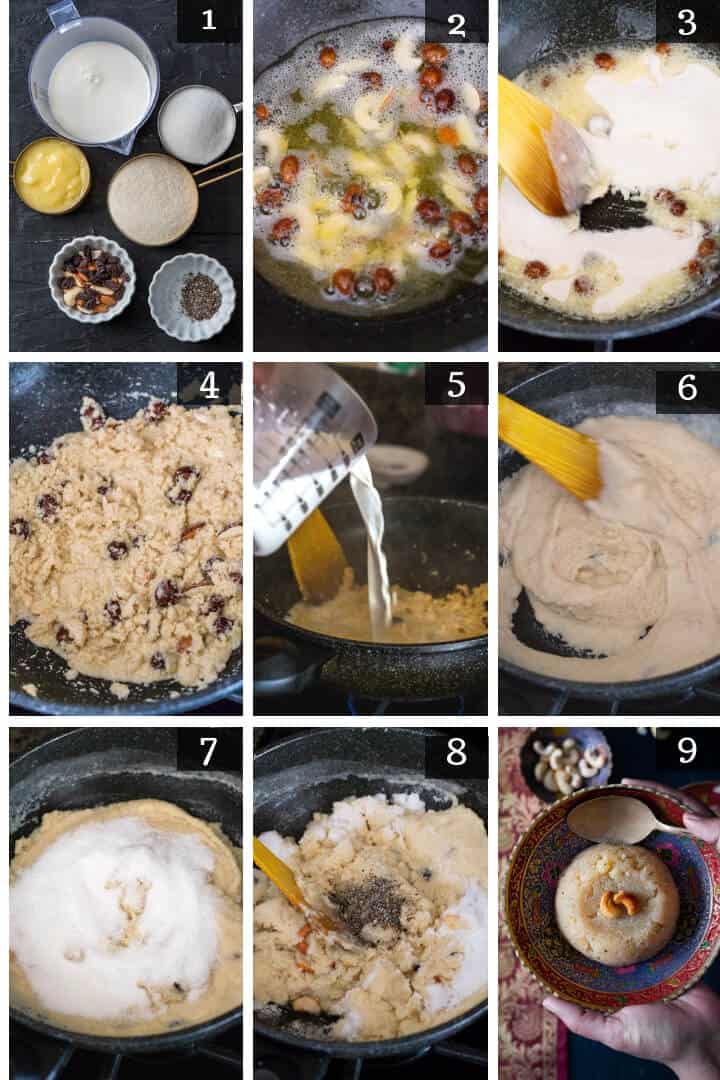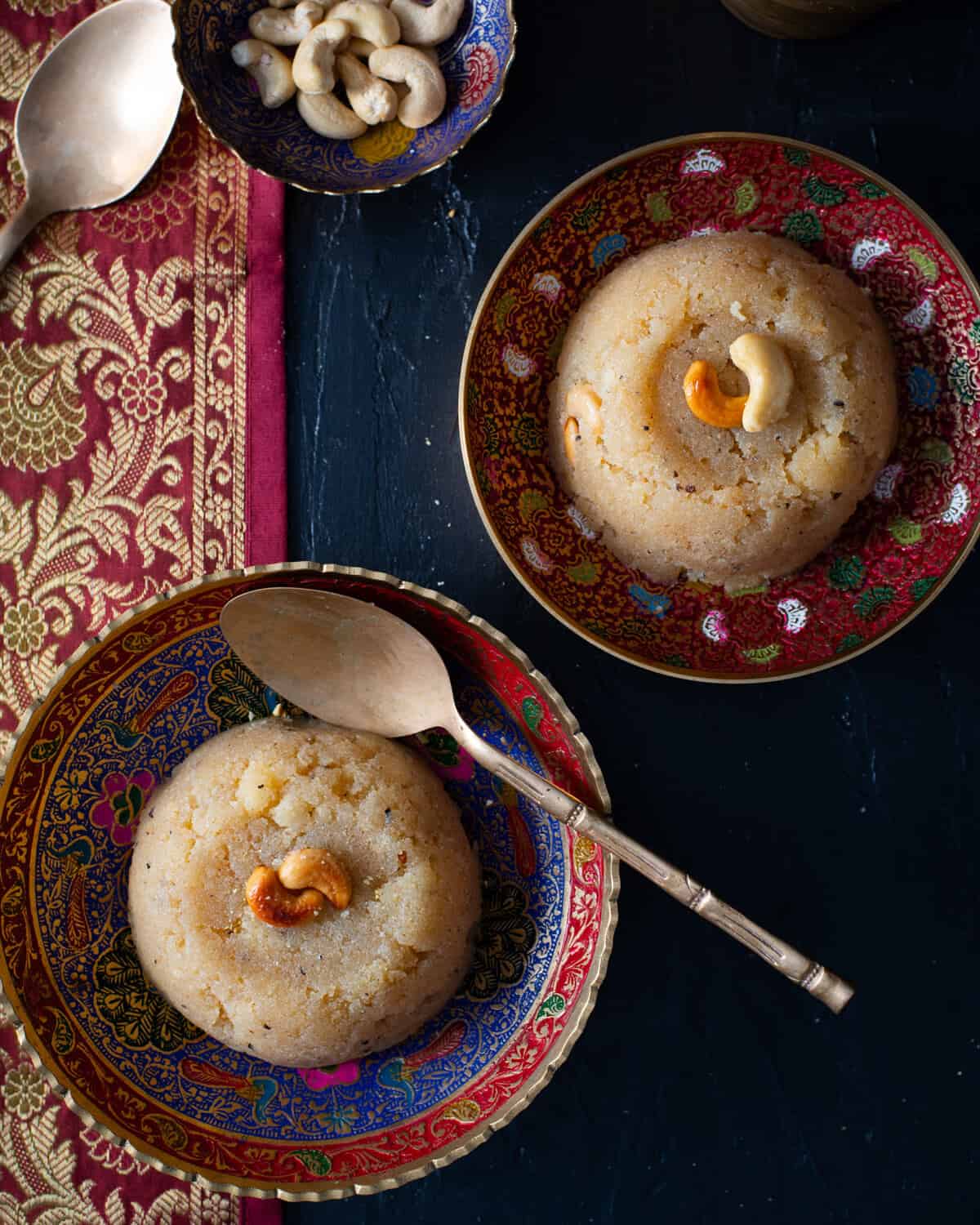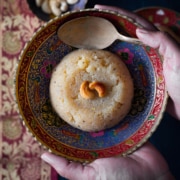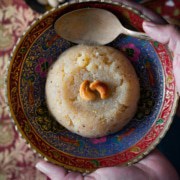Crumbly, sweet, and delicious – that’s how you’ll describe sheera also often known as suji ka halwa. Learn how one can make this easy and traditional dessert in lower than half-hour.

What’s sheera or suji ka halwa?
Ghee roasted semolina is combined with milk (or water), sugar, and cardamom powder to make this crumbly sweet dish.
Folks from Karnataka realize it as Sajjige, rava kesari, North Indians call it suji ka halwa, whereas it’s popularly often known as sheera in Maharashtra.
Actually, every country seems to have its own version. It goes by semolina pudding in Europe and the US whereas folks in the center east have their very own variant called Lekhmat Al Helwa.
Often served as prasad (an offering to god) during ashtami and Satyanarayana poojas, sheera holds an important place in Indian cuisine.
Before we get to the recipe, let’s address the million-dollar query here..
Is sheera good for you?
Before we answer the query, let’s have slightly chat about semolina – the important thing ingredient in sheera.
What’s semolina?
Semolina (rava / suji) is the coarse flour constituted of durum wheat and will likely be golden or off-white in color. It’s used for making a wide range of dishes including porridge, bread, and even pasta. It’s a high-gluten product that’s wealthy in vitamins, minerals, and carbohydrates.
Is semolina healthier than white flour?
Though each semolina and white flour are constituted of wheat, semolina is taken into account to be healthier than white flour.
White flour is bleached with a whitening agent, doesn’t have fiber or protein content in it, and is wealthy in carbohydrate.
Semolina, then again, is constituted of durum wheat and is a great source of Vitamin E and B. It’s slowly digested by the body, and hence you are feeling satiated after eating semolina.
Is semolina higher than whole wheat?
In comparison to whole wheat flour, semolina is taken into account less healthy because the carbohydrate concentration in it’s higher. Whole wheat flour, then again, incorporates your complete wheat kernel including bran, germ, and endosperm, and due to this fact is wealthy in fiber, vitamin, and mineral.
To wrap it up, semolina offers the next advantages (source – Semolina for weight reduction).
- Boosts energy level because it incorporates carbohydrates.
- It’s wealthy in iron and helps in improving blood circulation within the body.
- Incorporates calcium and is sweet to your bone.
- It is sweet for the nervous system due to the presence of magnesium, zinc, and phosphorous.
- Semolina has zero cholesterol.
So while semolina is great for you, sheera isn’t due to the amount of sugar that goes into the recipe. It’s a terrific once a month indulgence though but should you want something healthy to your breakfast this rava upma constituted of semolina is a terrific alternative.
How do you make the proper sheera?
Most folk would agree that making sooji halwa/ sheera is pretty straightforward. Despite that, I failed multiple times once I was starting out – I even have ended up with sheera that was clumpy, soggy, sticky, greasy, and whatnot.
Nothing just like the sheera my neighbor would serve the ladies within the neighborhood during Kanya pooja together with kala chana.
The very considered that sooji halwa makes my mouth water – the sheera she served was You possibly can eat it together with your fingers without them getting soaked with grease they usually were crumbly..i.e with one touch, the sheera piece would disintegrate.
That’s my idea of an ideal sheera.
Take a look at the step-by-step pictures to make sheera and follow the ideas mentioned below to make the proper sheera that all of us crave for.

Tricks to make an ideal sheera recipe
Follow the 1:1:1 ratio (ideally)
The recipe my mom taught me calls for using the identical amount of semolina, sugar, and ghee. While it ends in a terrific tasting sheera, I even have noticed that you can go barely easier on the ghee and sugar and still get similar results. For instance, for 1 cup of semolina, I exploit 3/4 cup sugar and ghee.
Roast semolina till it’s golden brown
.
Roast the semolina or sooji in ghee on a slow flame for a great 10-12 minutes. This ensures that the positive semolina grains don’t persist with one another and takes away the raw taste.
Note: When you are using dry fruits, start by sauteing them in ghee, after which add semolina.
Reduce the warmth while adding hot water or milk
If you add hot liquid, the sooji will begin to splatter out. Reduce the warmth first after which mix the liquid.
Stir the mixture immediately & always after adding the liquid
This can prevent lumps from forming.
When you are latest to creating sheera, ALWAYS measure the ingredients
Until you’re confident of your eyeballing skills, measure the ingredients because for this dish using the ingredients in the fitting proportion could be very vital.
Remember this – If the liquid content is less, it finally ends up being a dry mess. When you add more water or milk than required, then the final result will likely be soggy, sticky, and clumpy.
Lastly, make sure that you usually are not skimping on ghee. Ghee not only adds to the taste but ensures that your suji halwa doesn’t clump together.
Variations
Now there are just a few variations to this recipe that I do know of. For instance, some people add either pineapple or banana (elaichi kela) to offer it a delicious twist.
Serving suggestions
Sheera is commonly served as is for breakfast, as a dessert, and sometimes for a night snack if we’re craving something sweet. To make ashtami prasad, pair it with pooris and kala chana.

Other delicious Indian Dessert Recipes to enjoy
- Semiyan Kheer – a creamy and delicious dessert you can put together in a cinch.
- Gulab Jamun – India’s most beloved dessert and a favourite at Indian buffets!
- Rice kheer – Making Rice Kheer just got an entire lot quicker with this easy Easy Pot Kheer recipe. This Indian Rice Pudding comes out creamy and flavorful, without spending hours within the kitchen.
- Gajar halwa (carrot pudding) – Gajar halwa or Carrot pudding is a tasty dessert constituted of grated carrots, milk, and sugar. Learn this (almost) hands-free approach to creating one in every of India’s most beloved desserts using an Easy Pot.
- Moong dal payasam – In a Mangalorean household, festive celebrations are incomplete with out a delicious serving of Moong dal payasam or payasa. Learn how one can make this traditional dessert in half the time without compromising on the taste.

Click on the celebrities to rate!
Sheera / Suji Halwa (Semolina Pudding)
Crumbly, sweet, and delicious – that’s how you’ll describe Sheera also often known as Suji ka halwa. Learn to make this easy and traditional dessert in lower than half-hour.
- ¾ cup ghee
- ¼ cup dry fruits halved cashews, almonds, raisins
- 1 cup positive semolina suji
- 3 cups milk or water
- 1 cup sugar
- ¼ teaspoon cardamom seeds ground
Prevent your screen from going dark
-
In a wok or kadhai, add ghee over medium heat and once it’s hot, fry the dry fruits till they’re golden brown.
-
Add sooji and roast it for about 10-12 minutes till it’s evenly brown and fragrant.
-
In a saucepan, add water or milk and let it come to a boil.
-
Rigorously pour the water into the sooji mixture and stir repeatedly in order that no lumps form. Let the halwa cook for a few minutes.
-
Add sugar together with cardamom and proceed to cook till the sugar has melted and absorbed.
-
Serve hot.
Suggestions for a terrific tasting crumbly sheera
- Follow the 1:1:1 ratio (ideally)
The recipe my mom taught me calls for using the identical amount of semolina, sugar, and ghee. While it ends in a terrific tasting sheera, I even have noticed that you can go barely easier on the ghee and sugar and still get similar results. For instance, for 1 cup of semolina, I exploit 3/4 cup sugar and ghee.
- Roast semolina till it’s golden brown
.
Roast the semolina or sooji in ghee on a slow flame for a great 10-12 minutes. This ensures that the positive semolina grains don’t persist with one another and takes away the raw taste.
Note: When you are using dry fruits, start by sauteing them in ghee, after which add semolina.
- Reduce the warmth while adding hot water or milk
If you add hot liquid, the sooji will begin to splatter out. Reduce the warmth first after which mix the liquid.
- Stir the mixture immediately after adding the liquid
This can prevent lumps from forming.
- When you are latest to creating sheera, ALWAYS measure the ingredients
Until you’re confident of your eyeballing skills, measure the ingredients because for this dish using the ingredients in the fitting proportion could be very vital.
Remember this – If the liquid content is less, it finally ends up being a dry mess. When you add more water or milk than required, then the final result will likely be soggy, sticky, and clumpy.
Lastly, make sure that you usually are not skimping on ghee. Ghee not only adds to the taste but ensures that your suji halwa doesn’t clump together.
Variations
Now there are just a few variations to this recipe that I do know of. For instance, some people add either pineapple or banana (elaichi kela) to offer it a delicious twist.
Storage instructions
Store any leftover sheera within the refrigerator for about 5-6 days. Heat before serving.
Disclaimer: Approximate dietary information is provided as a courtesy and may vary depending on the precise ingredients/brands used. If you’ve gotten health issues, please work with a registered dietician or nutritionist.
Calories: 318kcalCarbohydrates: 37gProtein: 5gFat: 17gSaturated Fat: 10gCholesterol: 42mgSodium: 33mgPotassium: 149mgFiber: 1gSugar: 24gVitamin A: 119IUCalcium: 87mgIron: 1mg
This recipe was first published on Oct 16, 2018, and has been updated with updated text and directions on October 23, 2020.



